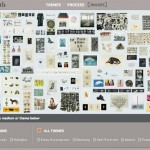In 2014 MoMA added Google Cardboard to its design collection. Earlier this year the Department of Film organized Slithering Screens, which highlighted notable projects such as James George’s and Jonathan Minard’s documentary Clouds and Lynette Walworth’s virtual-reality film Collisions (2016). But aside from these forays into virtual reality, not much else has been organized at the Museum (or most other art museums) around the burgeoning technology.

Posts in ‘Tech’
Actions Speak Louder than Words? Debating the Internet, Open Wide
In the fall of 2010, close to 4.8 million articles were downloaded from the password-protected, subscriber-only, nonprofit online academic journal repository JSTOR in an extended cyber hack that used the campus network at MIT. The articles represented roughly 80% of JSTOR’s total cache.
MoMA.org Turns 20: Archiving Two Decades of Exhibition Sites
It’s hard to believe that MoMA’s website, which celebrates its 20th anniversary today, is older than Google. It began with two relatively simple (by today’s standards) HTML exhibition sites for the Mutant Materials and Video Spaces exhibitions in 1995. Since then, over 200 exhibition sites have been created, documenting not only the Museum’s evolving curatorial interests, but also huge changes in Web coding and design.
Agile Evaluation: User Testing and the Feedback Loop for the Redesign of MoMA.org
MoMA.org is in the process of being redesigned. While it’s not unusual for a museum to tweak and even overhaul a website, it is the first time MoMA is using agile evaluation to help inform the redesign. Perhaps even more unique to this process, is the input from a group of “Audience Advocates” representing various departments at MoMA (including Digital Media, Education, Membership, Visitor Services, Management Information, and Marketing).
Object:Photo—Visualizing the Thomas Walther Collection

A screen grab of the Object:Photo website showing a map of selected events in László Moholy-Nagy’s life
When MoMA’s departments of Photography and Conservation set out to make a website to showcase the 341 photographs in the Thomas Walther Collection, the goal was to create an innovative resource that would take full advantage of the Internet’s interactivity. In December, MoMA launched Object:Photo, a digital research platform featuring four data visualizations that allow visitors to explore the materials, techniques, and art historical context of these 341 modernist photographs.
The MoMA Stores Celebrate Cyber Week with Tech Design Innovators
To celebrate Cyber Week, the MoMA Stores in New York are hosting in-store tech demos of some of the most exciting and innovative products that we sell.
The Art of Picasso as You’ve Never Seen It Before

Cover image of the e-book Picasso: The Making of Cubism 1912–1914, published by MoMA.
MoMA recently launched its first digital-only publication, Picasso: The Making of Cubism 1912–1914, edited by Anne Umland and Blair Hartzell, with Scott Gerson. This immersive, interactive study features over 400 high-resolution images and the latest research on 15 groundbreaking Cubist works created by Picasso between 1912 and 1914, and is available as an iPad app through the App Store, or an interactive PDF through MoMAstore.org.
Five Steps to Making the Art & Activity MOOC

The video crew captures Lisa leading a teacher professional development session in MoMA’s fourth-floor Painting and Sculpture Galleries. Photo: Stephanie Pau
On July 7, we launch Art & Activity: Interactive Strategies for Engaging with Art, a new Massive Open Online Course (MOOC). The course is part of an ongoing partnership with MOOC provider Coursera, to provide free professional development opportunities for K–12 teachers worldwide.
Playing Games at Museums and the Web
During my internship at MoMA, I have been working with the Department of Education’s digital learning team, focusing primarily on our online courses. It has been a fantastic experience, and I was given the opportunity to work on a cutting-edge digital initiative
The MoMA Art Lab App: Looking for Richard
The MoMA Art Lab iPad app, released in the Apple Store about a year ago, is intended for children aged seven and above. Nine interactive activities feature a work in the Museum’s collection, along with descriptions of the artists’ processes.
If you are interested in reproducing images from The Museum of Modern Art web site, please visit the Image Permissions page (www.moma.org/permissions). For additional information about using content from MoMA.org, please visit About this Site (www.moma.org/site).
© Copyright 2016 The Museum of Modern Art









